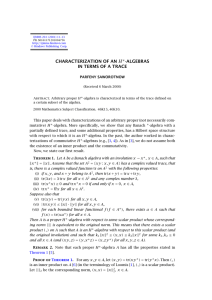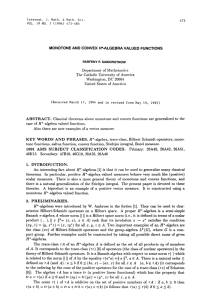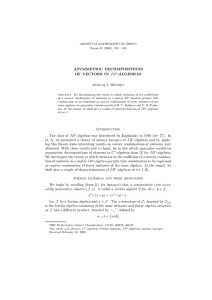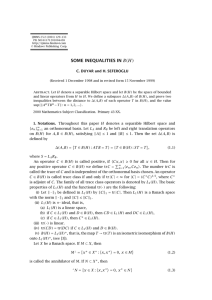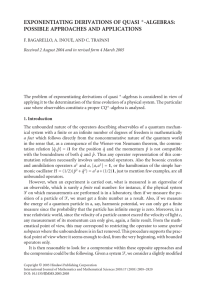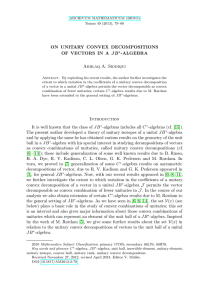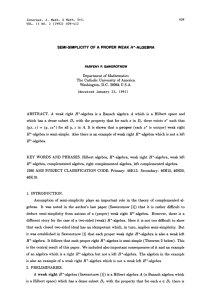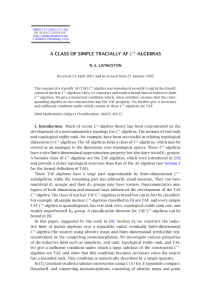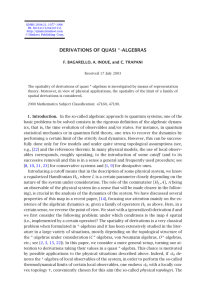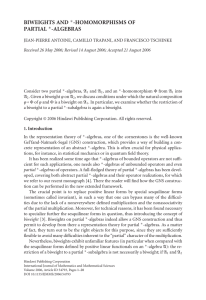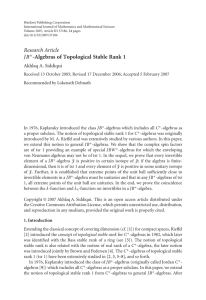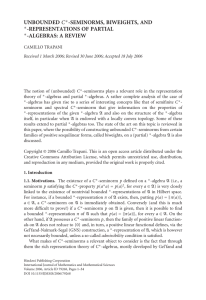Document 10442587
advertisement
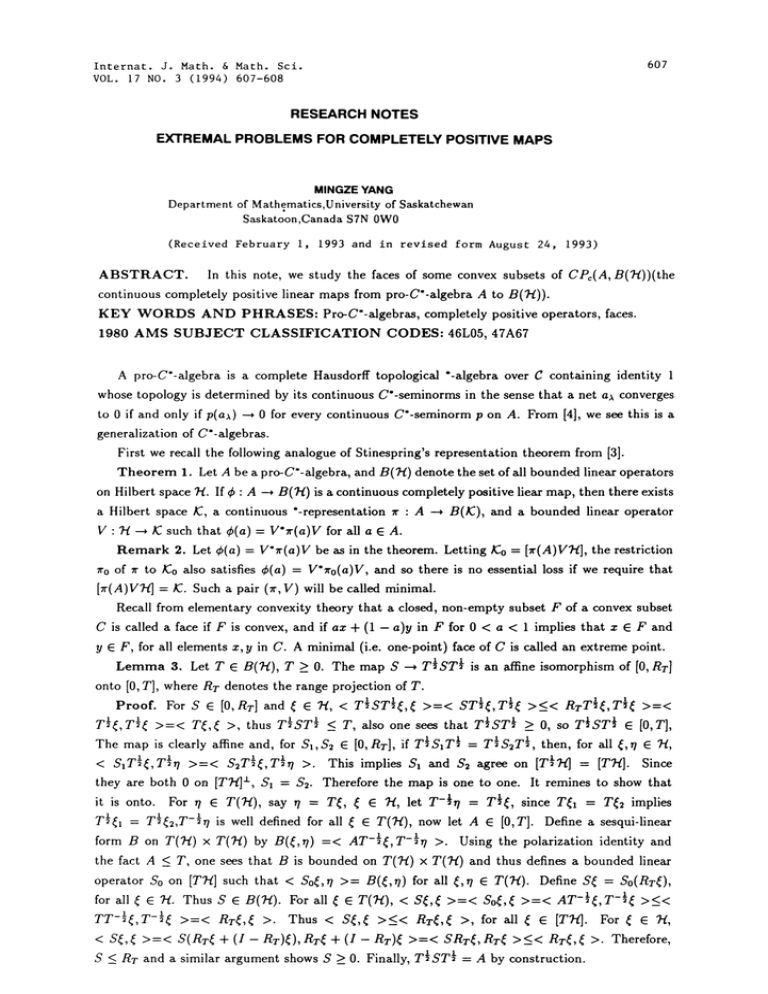
607
Internat. J. Math. & Math. Sci.
VOL. 17 NO. 3 (1994) 607-608
RESEARCH NOTES
EXTREMAL PROBLEMS FOR COMPLETELY POSITIVE MAPS
MINGZE YANG
Department of Mathematics,University of Saskatchewan
Saskatoon,Canada STN 0W0
(Received February 1, 1993 and in revised form August 24, 1993)
ABSTRACT.
In this note,
we
study the faces of some convex subsets of CPc(A,B(Tl))(the
continuous completely positive linear maps from pro-C*-algebra
A to B(’H)).
KEY WORDS AND PHRASES: Pro-C*-algebras, completely positive operators, faces.
1980 AMS SUBJECT CLASSIFICATION CODES: 46L05, 47A67
A pro-C*-algebra is a complete Hausdorff topological *-algebra over C containing identity
whose topology is determined by its continuous C*-seminorms in the sense that a net a converges
to 0 if and only if p(a)
0 for every continuous C*-seminorm p on A. From [4], we see this is a
generalization of C*- algebras.
First we recall the following analogue of Stinespring’s representation theorem from [3].
Theorem 1. Let A be a pro-C*-algebra, and B(?’/) denote the set of all bounded linear operators
on Hilbert space 7-/. If
A ---, B(’H) is a continuous completely positive liear map, then there exists
a Hilbert space C, a continuous *-representation r A
B(/C), and a bounded linear operator
/C
such that (a) Y*r(a)V for all a E A.
V"
Remark 2. Let (a) Y*r(a)Y be as in the theorem. Letting/Co [r(A)Y], the restriction
ro of r to/Co also satisfies (a) V*ro(a)V, and so there is no essential loss if we require that
[r(A)VT"/] =/C. Such a pair (r, V) will be called minimal.
Recall from elementary convexity theory that a closed, non-empty subset F of a convex subset
C is called a face if F is convex, and if ax + (1 -a)y in F for 0 < a < implies that x E F and
-
_
-
F, for all elements x, y in C. A minimal (i.e. one-point) face of C is called an extreme point.
Lemrna 3. Let T B(?’/), T > 0. The map S TST is an affine isomorphism of [0, RT]
onto [0, T], where RT denotes the range projection of T.
Proof. For S [0, RT] and e 7"/, < T1/2 ST(, >=< ST,T1/2 >_<< RTT1/2,T1/2 >=<
T1/2(, T1/2( >=< T(, ( >, thus T1/2ST1/2 <_ T, also one sees that T1/2ST1/2 >_ O, so T1/2ST1/2 [0, T],
y
.
The map is clearly affine and, for S1,S [0, RT], if T1/2S1T1/2
T1/2ST1/2, then, for all
< S1T1/2(,T1/2r/ >=< ST1/2,T1/2r/ >. This implies $1 and S agree on [T1/27"/]
[TT"/]. Since
show that
to
to
It
Therefore
the
is
remines
one.
one
they are both 0 on IT?’/] $1
map
S.
it is onto. For r/
T1/2, since TI T implies
7"/, let T-1/2r/
T,
T(7"/), say r/
T1/2(1 T1/2,T-1/2r/ is well defined for all E T(?/), now let A [0, T]. Define a sesqui-linear
form B on T(’H) x T(7"/) by B((,r/) =< AT-1/2,T-1/2r/ >. Using the polarization identity and
the fact A _< T, one sees that B is bounded on T() x T(7"/) and thus defines a bounded linear
-,
operator So on [TT"/] such that < S0,r/ >= B(,r/) for all ,r/ e T(). Define S
So(RT),
for all E 7-/. Thus S e B(7-/). For all
T(7"/), < S, >=< So, >=< AT-1/2,T-1/2 >_<<
TT-1/2(,T-1/2 >=< RT, >. Thus < S, >_<< RT, >, for all e [T?/]. For e 7"/,
< Sf,( >=< S(RT + (I RT)),RT + (I- RT) >=< SRT,RT ><< RT(, >. Therefore,
S <_ RT and a similar argument shows S >_ 0. Finally, TST A by construction.
M. YANG
608
Theorem 4. If B+ is the positive part of the unit ball in avon Neumann algebra A, then each
weakly closed face F of B+ has form F {L E B+I p < L < q} for a unique pair of projections
such that p < q in A.
Corollary 5. Each weakly closed face of [0, T] has form {L" T1/2pT1/2 < L < T1/2qT1/2 }, where p
and q are projections, and p < RT and q < RT.
We recall certain topological properties of the space of all operator-valued linear maps.
Let A be a pro-C’-algebra, ,nd let 7"/ be a Hilbert space, B(A, B(7"[)) will denote the vector
space of all continuous linear maps of A into B(). We shall endow B(A, B(7"I)) with a certain
weak topology, namely BW-topology. For r > 0, let Br(A,B(7"I)) denote the closed ball of radius
: B(A, t(t))
{ t(m, (7)); II(a)ll _< rp(a),a A}, where because ff is continuous, there
exists p S(A) such that II(a)ll _< Mp(a). First we topologize Br as follows, by definition, a net
4(a) in the weak operator topology,
Br(A,B(7"I)) converges to 8 fi Br(A,B(7"t)) if bo(a)
for every a A. A convex subset b/of B(A,B(7"[)) is open if blf’)Br(A,B(7"l)) is an open subset
of B(A, B()) for every r _> 0. The convex open sets form a base for a locally convex Hausdorff
topology on B(A, B(7-/)), which we shall call the BW-topology.
Now we come to discuss the facial structure of completely positive operators. First we give a
lemma. Let b(a) V’r(a)V be a continuous completely positive linear map as in Theorem 1.
Lemma 6. The mapping from {T E r(A)’’ 0 < T < I} to [0, b] defined by br(a) V’Tr(a)V
is a homeomorphism related to the restriction of weak operator topology of von Neumann algebra
rr(A)’ and BW-topology of B(A, B(7"/)).
Proof. [0, b] is a BW-closed subset of B(A,B(7"t)). If {bo} is a net in [0,b], and bo converges
to 40 [0, b] in BW-topology. We have for every a A, bo(a)
40(a) in weak operator topology.
That is, for every f,r/ 7-/, < 4o(a)(f), r/>-< q0(a)(), r/>. But we have bo(a) V’Tor(a)V, and
bo V’Tor(a)V, where To, To c= r(A)’, and 0 < To, To < I. So we have < V’Tor(a)V(),rl >-<
V’Tor(a)V(f),r >, for every a,b A, and f,r/ 7"/, we have < Tor(b)V(f),r(a)V(rl) >--<
Tor(b)V((),r(a)V(rl) > but R. [r(A)VT"/], so To
To in the weak operator topology. The
other direction is similar.
Theorem 7. Given two completely positive operators q) and ff with q) < b. Let ff V’rV
be the minimal representation of b, then the BW-closed faces in [0, q] are of the form {bt.; L
r(A)’,(l-T)1/2p(I-Z)1/2 +T < L < (I-T)1/2q(I-T)1/2 +T}, where p and q are projections in r(A)’
and p < Rt-r, q < Rt-r, and @ V’TrV.
Proof. It is an easy consequence of lemma 6 and the above corollary 5.
Corollary 8. Let b V’rV be the minimal representation of if, then the BW-closed faces in
[0, if] are of the form {br; T r(A)’, p < T < q}, where p and q axe projections in r(A)’.
_
_
.
-
Acknowledgement. The author wishes to express his deepest gratitude to Professor K. F. Taylor,
for giving him the proof of Lemma 3.
References
1. C.A.Akemann and G.K.Pedersen. Facial Structure in Operator Algebra Theory, preprint, 1991.
2. W.B.Arveson. Subalgebras of C’-algebras, Acta Math., 123 (1969), 142-224
3. S.J.Bhatt and D.J.Karia. Complete Positivety, Tensor Products and C’-Nuclearity for Inverse
Limits of C’-Algebras, Proc. Indian Acad. Sci. 101(1991) 149-167.
4. N.C.Phillips. Inverse Limits of C’-algebras, J. Operator Theory
19(1988)
159-195




